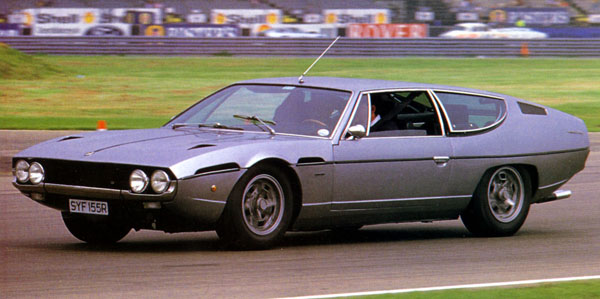

1968 Lamborghini Espada
Released in 1968, Espada was Lamborghini’s first four-seat vehicle and its biggest selling
model for years. Encapsulating an exceptional approach to technical innovation, thanks to
the front-mounted 4.0-litre Lamborghini V12 engine it was always an extremely fast grand
tourer despite the step up in size.
It could comfortably seat four adults and had more space for both luggage and passengers
than the 400 GT 2+2 (its predecessor) and the Isler 400 GT 2+2. In addition, Espada
featured truly outstanding finish, with generous amounts of leather and other refined
materials, as well as the option of fitting air conditioning.
Power steering was introduced as an option in 1969 and it was included as standard from
1972 onwards. A version with automatic transmission was available from 1974.
The technical cornerstone of the Espada was the 60-degree V12 engine that was first
produced in 1963 with a displacement of 3.5 litres, which had already been increased to
4.0 litres (3929 cc) in 1964.
It is a remarkable example of engine development technologies, and it was capable of
delivering 325 hp (242kW) at 7200 rpm when it was first fitted in the Espada. This
increased to 350 hp (260kW) at 7500 rpm in the Espada Series II, which was presented in
1970.
Fed by six Weber 40 DCOE side-draft carburetors, the V12 had a compression ratio of
9.5:1 (which increased to 10.7:1 from the Series II onwards) and two chain-driven
overhead camshafts per bank.
It weighed just 232kg thanks to substantial use of aluminum to make not only the cylinder
head but also the crankcase and the pistons.
It was front-mounted in a position that was slightly further forward compared to the
previous Lamborghini 350/400 GT engines, in order to make the interior roomier. Thanks
to the large opening below the aluminum hood, it was easily accessible.
The chassis was based on that of the 400 GT but it was lengthened so that the wheelbase
reached 2650mm and it was also widened, with the wheel track increasing to 1490mm.
It had four-wheel independent suspension, with double wishbones and coil springs.
In November 1968, an Espada “Lancomat” with hydropneumatic suspension went on
display at the Turin Motor Show. The system was made available on demand, but in the
end, it was chosen by very few owners.
The Espada was an extremely fast grand tourer that was capable of reaching a top speed
of between 245 and 260 km/h and keeping up with the sportier Miura in most conditions.
When it was first unveiled, the Espada was the fastest four-seat car in the world. Featuring
boxy shapes as part of a highly innovative design by Carrozzeria Bertone, it proved to be a
long-lasting commercial success.
Its versatility and roomy interiors – despite a height of just 1190mm – meant that it was
suitable for much more frequent use, thus significantly expanding the customer base.
A total of 1226 cars were produced across the three series: 176 of the Espada 400 GT
Series 1 between 1968 and 1969, 578 of the Espada 400 GTE Series II between 1970 and
1972, and 472 of the Espada 400 GTS Series III between 1972 and 1978.
The Espada VIP was presented in 1971. It was based on the Espada 400 GTE Series II
and just 12 were made. The first models in this special series came in a special orange
hue and had orange and black leather upholstery. Later vehicles were made in other color
combinations.
Inside, the Espada VIP had a mini-bar and a refrigerator in the rear side panels and a
Brionvega Algol 11 television on top of the transmission tunnel to keep the passengers in
the rear seats entertained.
The VIP is one of the most sought-after models among Espada collectors today. Many
famous people owned the Espada including Beatle Paul McCartney. His wife Linda often
drove the car, but they disposed of the car after it rolled into a nearby pond when she left it
in neutral and forgot to put on the handbrake. That car is thought to now be somewhere in
Austria.
TV host Jay Leno has owned one of the very first Espada Series 2 models, which was
made in 1969.









Hi Chris,
Re- Espada VIP information.
The first known Bertone VIP was a 1970 model. It was Presented by Bertone at the 1970 52nd Turin Motor Show. See this Bertone VIP in the 28/10/1970 movie- https://www.youtube.com/watch?v=xYVGnIK6r4M. , it is on the Bertone Prototype stand behind the Bertone Lancia Stratus HF Zero.
Note the colour is not orange hue, it is a “one off” Pearl Champagne.
This Concept VIP was known as the TV / Mini bar car. To fit the TV they used a special Prototype Console (deleting the front ash tray and mid drop down section). This Bertone Concept VIP was the only one that had this. Check out 9 of the 10 known VIP interior photos at lamborghiniespada.com. . Note two are 1970 models. The last know VIP is a Series 3.
Regards Alan